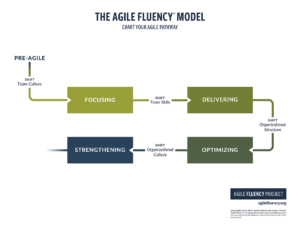It’s spread beyond the product development teams. You hear Marketing and HR talking about Agile as you pass through on your way to the lunchroom.
Your Scrum Masters haven’t had advice for the teams in months. It hasn’t been easy, and the cost was pretty high. Management resisted a little, but the model has made steps very clear, maturity means going all the way. Nobody wants to be less mature than they can be. Even better, you’re pretty sure your team has made it.
Full. Agile. Maturity. Agile Nirvana.
Of course, we all know that’s not possible to achieve. What we need to think about is whether it’s even something to strive for.
I’ve always believed in using the right tool for the right job. That used to mean things like using a Mac for creative work and a PC for spreadsheets. The world is not nearly this black and white anymore, and honestly it probably never was. These days it often means sometimes Scrum is a good starting point, but other times Kanban makes more sense.
I heard a phrase from Ahmed Avais, founder of Agile 7, in the last year and it’s really stuck with me. Before we go any further, you’ve got to check out his work. I give him all due credit. The phrase was “Agile fit for purpose.”
“All models are wrong but some are useful.” – George Box
This quote comes up when talking about models a lot, so it’s useful here too. We’re going to talk about a model that helps you shape an organization’s agile transformation. One that you can use to help teams get better faster. This isn’t another maturity model where everyone tries to become the best though. This model is about fluency and finding the right level of fluency for your organization.
In a fluency model, the goal isn’t passing a test. The goal is exhibiting proficiency in a skill at all times. In language, a person has varying levels of fluency depending on how well they can maintain their grasp on a language under various levels of stress. Maybe they can read and write German, but not speak it. Given the chance to slow down, they may be able to communicate in Spanish perfectly, but it may only be French they can communicate in under duress. They are more fluent in Spanish than German, but not as fluent as they are in French.
The biggest argument for a fluency model versus a maturity model is that a maturity model implies every team should strive to make it all the way to the end. Anything less and the team is immature and ripe for improvement. A Fluency model assumes that each stop along the path is a place where a team can become fluent. One stop is not inherently any better or worse than another stop.
Go back to our budding linguist. If they only need to read and write German, why should they spend a lot of time learning to listen to and speak it? Will they be significantly better at reading and writing it if they can also speak it? Will the investment of time and money on learning to speak it help enough with writing it to make sense?
These are the things I’m thinking of when I start looking for what purpose a company has, and how would Agile best fit for them. I’m not looking to push them to the far side of a maturity model. That may be more than they need, a waste of time and resources. Instead of blindly following a maturity model to the end, they should look at what level of agile fluency fits their purpose.
What is this fluency model I use to help them find it? The Agile Fluency® Model.
This page of The Agile Fluency website is a great resource for learning more, as is contacting me for an initial free consultation. I’ll give a couple of highlights below, but there is also a video and an article linked out from there to get much more detail.
The first highlight is fluency over maturity. Fluency is a state of having achieved skillful practice while under pressure. It is achieved through deliberate practice. Individual fluency contributes to team fluency and team fluency contributes to organizational fluency.
The next highlight is that not all organizations need the same thing. In The Agile Fluency Model we talk about Focusing, Delivering, Optimizing, and Strengthening as different target zones. Each zone requires a different level of investment and has a different length of time before that investment will pay off. Different organizations, even different business units within larger organizations, will need to target different zones for different reasons.
There is a lot more depth and detail available here. My point today is that each organization has different needs and coaching will help them realize what they need to do to get the right level of the right flavor of agile for their situation.
Get in touch with me here to set up an initial call and talk about your needs and how I can help, whether you have only a couple of teams or multiple business units in your organization.
 It happens to every team. The sprint is coming to an end and the team has nothing to demo. Is it because no progress was actually made? Unlikely. Usually, it’s because the progress isn’t something that can be easily shown. In this situation, most teams want to skip the demo. You can’t blame them really. The team is likely embarrassed and almost certainly frustrated. They worked hard but don’t feel as if they have anything to show for it.
It happens to every team. The sprint is coming to an end and the team has nothing to demo. Is it because no progress was actually made? Unlikely. Usually, it’s because the progress isn’t something that can be easily shown. In this situation, most teams want to skip the demo. You can’t blame them really. The team is likely embarrassed and almost certainly frustrated. They worked hard but don’t feel as if they have anything to show for it.





















